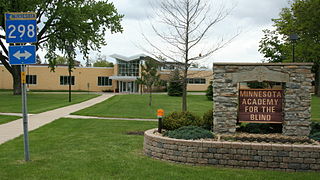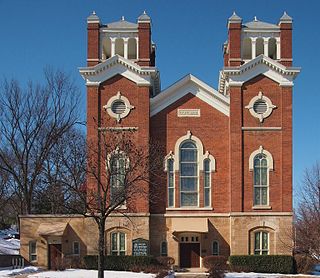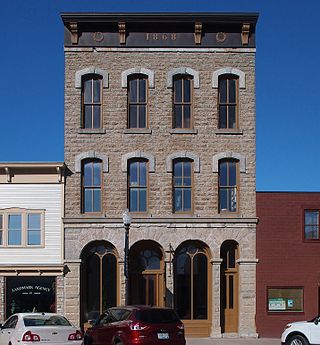The National Register of Historic Places (NRHP) is the United States federal government's official list of districts, sites, buildings, structures, and objects deemed worthy of preservation for their historical significance or "great artistic value". A property listed in the National Register, or located within a National Register Historic District, may qualify for tax incentives derived from the total value of expenses incurred in preserving the property.

Faribault County is a county in the U.S. state of Minnesota. As of the 2020 census, the population was 13,921. Its county seat is Blue Earth.

Faribault is a city in, and the county seat of, Rice County, Minnesota, United States. The population was 23,352 at the 2010 census. Faribault is approximately 50 miles (80 km) south of Minneapolis–Saint Paul.

Nerstrand is a city in Rice County, Minnesota, United States. The population was 294 at the 2018 census.

The Minnesota Historical Society (MNHS) is a nonprofit educational and cultural institution dedicated to preserving the history of the U.S. state of Minnesota. It was founded by the territorial legislature in 1849, almost a decade before statehood. The Society is named in the Minnesota Constitution. It is headquartered in the Minnesota History Center in downtown Saint Paul.

The Texas Historical Commission is an agency dedicated to historic preservation within the U.S. state of Texas. It administers the National Register of Historic Places for sites in Texas.
Alden B. Dow, an architect based in Midland, Michigan, was renowned for his contributions to the Michigan Modern style. Beginning in the 1930's, he designed more than 70 residences and dozens of churches, schools, civic and art centers, and commercial buildings during his 30+ year career. The Midland Center for the Arts, the 1950s Grace A. Dow Memorial Library, and his former residence, the Alden Dow House and Studio, are among the numerous examples of his work located in his hometown of Midland, Michigan. He is the son of industrialist Herbert Dow, the founder of the Dow Chemical Company, and his wife, philanthropist Grace A. Dow. Dow is known for his prolific and striking Modernist architectural designs.

The Minnesota State Academies are two separate schools, the Minnesota State Academy for the Blind and the Minnesota State Academy for the Deaf, both established by the legislature in 1858. The Academy for the Deaf opened doors in 1863 and the Academy for the Blind opened doors in 1866. They are public residential option schools for Minnesota children with hearing loss and vision loss, serving students from birth to age 21. They are operated by the state.

Minnesota State Academy for the Blind (MSAB) (formerly known as the Braille and Sight Saving School) is a public school in Faribault, Minnesota, United States. Its mission is the education and life education of blind, visually impaired, and deaf-blind learners from birth to age 21. The school has a residential option program and provides 24-hour programming including Braille, independent travel, assistive technologies, and individualized educational services. Students often have multiple disabilities and come from all regions of the state.

The Minnesota State Academy for the Deaf (MSAD) is a public residential school serving deaf children in Minnesota, United States. It is one of two Minnesota State Academies in Faribault and operated by the state for particular student populations.

The Alexander Faribault House is a historic house museum in Faribault, Minnesota, United States. Built in 1853, it was the first wood-frame house constructed in Rice County, Minnesota. It was built by fur trader Alexander Faribault in the Greek Revival style. Besides serving as a house, it also served as a civic center, polling place, and a church. The local address of the house is 12 First Avenue, Faribault, MN. The house was listed on the National Register of Historic Places in 1970.

This is a list of the National Register of Historic Places listings in Rice County, Minnesota. It is intended to be a complete list of the properties and districts on the National Register of Historic Places in Rice County, Minnesota, United States. The locations of National Register properties and districts for which the latitude and longitude coordinates are included below, may be seen in an online map.

This is a list of the National Register of Historic Places listings in Faribault County, Minnesota. This is intended to be a complete list of the properties and districts on the National Register of Historic Places in Faribault County, Minnesota, United States. The locations of National Register properties and districts for which the latitude and longitude coordinates are included below, may be seen in an online map.

The Sibley Historic Site is the site of Henry Hastings Sibley's home, who was the regional manager of the American Fur Company and Minnesota's first governor. It is one of the 26 historical sites that are operated by the Minnesota Historical Society. Located in what is now the city of Mendota, the site consists of four limestone buildings and a large lawn area. Three of the buildings are open for touring, including a fur company cold store from 1843 and the 1840 home of fur trader and hotelier Jean-Baptiste Faribault.

The Bonde Farmhouse is a historic farmhouse located in Wheeling Township in Rice County, Minnesota, United States, approximately 1 mile (1.6 km) from Nerstrand. The private home was placed on the National Register of Historic Places (NRHP) on April 6, 1982. The farmhouse is significant both for its association with a prominent Norwegian immigrant family as well as its local limestone construction and outstanding integrity.

Charles N. Daniels (1828-1892) was an American architect active in Minnesota, North Dakota, and Washington.

Batchelder's Block is the second-oldest surviving commercial building in Faribault, Minnesota, United States; constructed in 1868. It was listed on the National Register of Historic Places in 1990 for having local significance in the themes of architecture and commerce. It was nominated for its associations with Faribault's early commercial development and the city's emergence as a regional commercial center, and for being a well-preserved example of Faribault's early commercial architecture.

The Faribault Viaduct is a reinforced concrete highway bridge which carries Minnesota State Highway 60 over the Straight River in Faribault, Minnesota, United States.




















